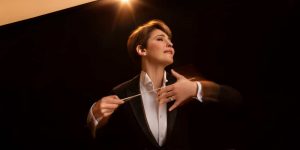
By Dennis D. Rooney
In January, I reviewed the second concert of The Symphonia’s 17th season, conducted by Andrés Cárdenas. At that time, I noted tonal imbalance among the string choirs, with the violins sounding astringent.
Sunday’s concert at Boca Raton’s St. Andrews School (the third of the season), heard from an identical seat in Roberts Auditorium, offered dull sonority in the violins that were consistently underpowered and lacking projection, particularly when playing with woodwinds and brass.
Julia Adolphe’s Shiver and Bloom, composed in 2017 for and first performed by Jeffrey Kahane and the Los Angeles Chamber Orchestra, was an intriguing opener. Its 13-minute length offers timbral and registrational contrasts that alternately evoke the perceived divide between the mind and the body. The device is an old one, but Adolphe (now 33) brought good color sense and intriguing atmosphere to her musings on the subject. Guest conductor Laura Jackson, now in her 11th season as music director of the Reno Philharmonic, guided the Symphonia through a successful account.
In 1937, Benjamin Britten accepted a commission from the conductor Boyd Neel for a work for string orchestra to be premiered at that summer’s Salzburg Festival. Working quickly, the 23-year old Britten drafted his Variations on a Theme of Frank Bridge in 10 days and completed the scoring by 12 July.
Both Bridge and Britten journeyed to Salzburg to attend rehearsals. The work was given its concert premiere, as planned, on Aug. 27, 1937. Dedicated “To F.B. A tribute with affection and admiration,” the nine variations are preceded by an Introduction and the Theme (from the second of Bridge’s Three Idylls for string quartet, Op. 6, No. 2), and followed by a concluding Fugue and Finale. Each variation refers to an aspect of Bridge’s personality, e.g., his integrity in the Adagio, his energy in the March, his charm in the Romance. Britten included all the titles in the score that he presented to Bridge but withheld them from the printed score.
In the absence of a printed program, a screen descended from the Roberts Auditorium ceiling in order to show the procession of each part to the audience. In her prefatory remarks, Laura Jackson noted that the work is only rarely performed, in answer to which one must point out its difficulty as a main reason. In addition to being Britten’s tribute to a beloved teacher and mentor, the Variations on a Theme of Frank Bridge was intended as a showpiece to introduce both Britten and the Boyd Neel Orchestra to an important international audience. Any successful performance must be played brilliantly. Neither the Symphonia strings nor the acoustics of the room made much brilliance possible, but the music, particularly as it reflected the young composer’s determination to put his best foot forward, gave much pleasure.
A man seated close to me mentioned to his companion that he had heard another performance of the Beethoven Piano Concerto No. 3 (in C minor, Op. 37) only three weeks earlier and how unusual that was. He was referring to the performance by the Palm Beach Symphony Orchestra and pianist Rodolfo Leone on March 7. I also heard that performance, and I happily observe that the one played by the Symphonia and Canadian pianist Marika Bournaki (b. 1991), was a far more interesting and enjoyable account: larger in scale; more decisive in manner; and graced by a warm instrumental tone.
Bournaki’s overuse of the pedals was often bothersome, but her confidence carried the day, despite some weak intonation and sloppy ensemble in the orchestra.